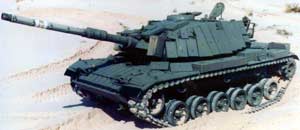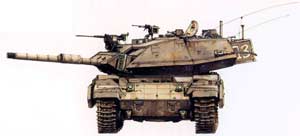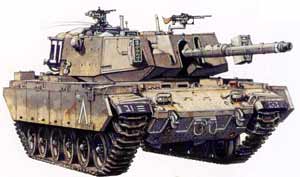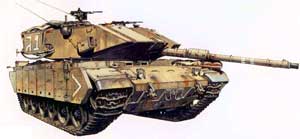| Designation: | Magach |
 |
|---|---|---|
| Manufacturer: | Israeli Ordnance Corps Workshops | |
| Product type: | Armoured Vehicles | |
| Name: | Modernization of the vehicle |
The Magach is the name given to the M48 and M60 tanks used by the IDF. The M48s were systematically upgraded after entering IDF service in 1965, making them virtually indistinguishable from the M60s. Early model machines were up-gunned, with licence-built copies of the British L7 105mm cannon, fitted with American-style, vertical breech mechanisms. Additional incremental improvements, implemented for all Israeli main battle tanks (MBTs), saw the introduction of the Urdan low-profile commanders' turret, increased external stowage, thermal sleeves for the cannon, and a 60mm mortar and extra machine guns mounted on the roof. Major changes included a Teledyne Continental AT)S-1790-2A diesel power pack and Blazer reactive armour. The Magach with Blazer is known as the Magach 6B.
By 1985, despite all the upgrades, the Magach was becoming increasingly outclassed by MBTs appearing in the enemy tank fleets. Particularly problematical was the inadequate level of ballistic protection. The turret of a tank is the most likely point to be hit in tank-versus-tank conflict. The thickest part of the M60's turret is 254mm of RHA. Much of its armour is a great deal thinner. By the 1970s a typical KE round could pierce approximately 400mm of RHA. By the 1990s armour-piercing, fin-stabilised, discarding-sabot (APFSDS) KE rounds fired from 120 and 125mm cannon could penetrate 800mm of RHA.
Blazer kits weighed between 800 and 1,000kg. Against HEAT warheads, they gave a tank the equivalent protection of an additional 10 tonnes of steel. Despite efforts to improve Blazer, including changes to its configuration and composition, it remained inadequate against KE projectiles.
Adding more RHA would have imposed an unacceptable weight penalty. Lighter, passive materials were required, capable of defeating both HEAT and KE rounds. The IDF decided to borrow from the evolving Merkava project and introduce its new ballistic materials to the Magach upgrades. This process led to major new variants of the Magach entering into service by the mid-1990s.
- The Magach 7A
(Aleph being the Hebrew designation.) This tank is equipped with passive armour arrays and associated changes to the power pack and running gear aimed at coping with the extra weight. A new fire control system (FCS) is installed.
- The Magach 7C
(Gimel being the Hebrew designation) This tank is similar to the Aleph, although its armour is of a later generation.
- The Magach IB
(Bet being the Hebrew designation.) This tank was a short-lived interim model between the 7A and 7C. Reputedly only a mere handful of the Magach 7B were built before the 7C, with its better ballistic shaping, supplanted them.
Israeli tanks tend to be modernised in relatively small batches. This is partly owing to cost but also to the need not to disrupt operational capability. Passive armour arrays are expensive and not all Magachs were upgraded with them. Consequently older models of the Magach remained in service alongside newer variants. In November 1997 two Magach 6Bs fitted with Blazer were hit by heavy ATGMs fired by Hezbollah guerrillas. Unlike in 1982, when repeated RPG and ATGM hits had failed to penetrate Blazer-equipped tanks, on these occasions the tanks' armour was breached. The result was one dead loader and five other crewmen wounded. The writing was on the wall. Not only was Blazer ineffective against KE rounds, it was becoming vulnerable to newer-generation HEAT warheads such as that carried by the Spigot ATGM. In 1999 the IDF requested a cheap but effective bolt-on armour package to upgrade the Magach 6B. IMI's response was astonishingly swift. It took only ten weeks from inception to production of the package for what was to be termed the Magach 6 BATASH. (BATASH is an acronym taken from the Hebrew term Bitachon Shotef, which means 'overall security').
Both the Magach 7A and Magach 7C have passive armour arrays capable of coping with most KE and HEAT attacks. The actual combination and configuration of the laminates used in their respective composite armours are classified. The Magach 7A first entered service in the early 1990s, the Magach 7C in the mid-1990s. Both variants of the tank are fitted with add-on armour to the turret, and the front of the hull. Side skirts are also fitted. These are mounted on heavy-duty springs to help prevent them being ripped off when the tank is manoeuvring. The first double panel of the side skirts on each side is made up of passive armour laminates and the others of steel. The passive armour side skirts have a sturdy central hinge allowing access to the running gear.
The Magach 7A has flat-sided, riveted, applique armour modules. In comparison, the modular armour kit for the Magach 7C, code-named 'Envelope' by its manufacturers IMI, has better ballistic shaping. The arrowhead-shaped turret front of the Magach 7C does, however, make it difficult for the driver to bail out from a burning tank, though IMI made sure that at whatever angle the turret is positioned, the driver can still exit from his hatch.
The Magach BATASH's turret has a hybrid armour package incorporating reactive as well as passive layers. One senior company representative has referred to it as being designed specifically for LIC operations. It is likely that the hybrid package is optimised to protect against multiple heavy ATGM strikes. The glacis of the Magach BATASH is protected by second generation 'Super Blazer' reactive armour tiles. The side skirts are the same as those of the Magach 7.
Magachs remaining in service are systematically being retrofitted with Moked ('Focus') laser warning systems, which alert the crew if the tank has been 'painted' by a targeting laser. In addition Magachs have been fitted with a fire and explosion suppression system from the Israeli manufacturer Spectronix.
The Magach variants retain their 105mm cannon. Improvements have been made to the fire control systems and in the lethality of the ammunition. The turret's hydraulic drive has had to be beefed up to compensate for the weight increase caused by the applique armour.
Some Magach 6Bs had been fitted with an improved FCS. The new system was known by the IDF as the Gal (wave), although offered on the international market by its manufacturers Elbit/EL-OP as the Matador. Those Magach 6Bs fitted with the new FCS were known as the Magach 6B Gal. The same Gal FCS was adopted for the Magach 7. The original optical rangefinder has been supplanted by a laser whilst the gunner has new day and night sights. There is a new ballistic computer with associated meteorological sensors and an Israeli-developed thermal sleeve assists gun accuracy. To enhance performance further, the gunner's semi-stabilised sights are slaved to the gun, which is independently stabilised. The commander has his own sights housed in the hemispherical armoured shell on the right turret flank; this used to contain part of the old optical rangefinder system.
Although the actual ammunition load is classified, the Israelis have a good reputation for developing and manufacturing tank rounds. It is likely that the modernised Magachs carry the APFSDS-T M413 kinetic energy round, which is believed to have excellent penetrative capabilities.
Magachs carry a 60mm mortar fitted to the turret roof, for use against enemy infantry.
The weight of a baseline M60 is 49.7 tonnes. The Magach 7 variants with their additional armour are thought to be between 54 and 55 tonnes. This weight gain occurred even though Magach tracks were replaced by lighter and more durable all-steel ones, sourced from the Merkava, which saved 1.7 tonnes. Given the weight gain, attention had to be paid to maintaining mobility. The original 750hp power pack was replaced by a 908hp General Dynamics Land Systems Division AVDS 1790-5A diesel coupled with the same automatic transmission as used in the Merkava 1. In addition the Israeli firm Kinetics has carried out some major upgrades of the running gear. New shock absorbers have been fitted to roadwheels one, two and six, along with hydraulic bumpers to roadwheels one, two, five and six. New high-strength torsion bars are now standard. This combination has allowed roadwheel travel to increase from 180 to 200mm. Dissipated energy absorption per suspension station has risen by a very impressive 355 per cent.
In the real world these changes have given the Magach 7A and 7C greatly improved cross-country performance and acceleration when compared with the M60. Crew fatigue is reduced. As hull stability is enhanced, weapon accuracy is also improved.
The Magach 6 BATASH is not thought to have had any major weight gain from its armour package. What weight gain there has been is compensated for by the weight reduction achieved by fitting lighter Merkava-type tracks. Consequently it is unlikely to have been fitted with the more powerful engine.
The post-1985 upgraded tanks have seen combat, not against enemy armour, but in the bitter fighting against Hezbollah and Palestinian guerrillas. The tanks have in effect been used as mobile pillboxes, making use of their relative invulnerability and sophisticated sensors to cut back on casualties.
The Magach's extra armour has proved literally a life saver. In autumn 1997 a Magach 7A was reported to have been hit by salvos of Sagger missiles, in an ambush launched by Hezbollah guerrillas. Twenty Saggers hit the tank, two of which, fired downwards from hilltop positions, actually penetrated it. Israeli operational analysis determined that with an applique suite of Blazer rather than passive armour, nine warheads would have penetrated. However, not even the better-protected Magach 7C could cope with the massive roadside charges that both Hezbollah and the Palestinians have started to employ. On 15 February 2003 four soldiers were killed, and their Magach 7C destroyed, when it ran over a roadside charge in the Gaza Strip. The charge, according to the Israelis, weighed 100kg. No tank could withstand such an attack against its weak underbelly.
Little is known about Magach BATASH operations other than that the type saw action in the West Bank during the Palestinian Intifada of 2002-3.
As new armour technologies become available, the modular nature of the add-on armour kits will allow further minor upgrades to the Magach. For example, some Magach 7Cs have been seen in 2003 with extra armoured panels added to the front of the turret roof.
Whilst it is unlikely that the Magach will be developed much further in IDF service, an extensive upgrade package has been sold to Turkey based upon the Magach 7C. The upgraded tank, known as the Sabra, has some fine tuning of its ballistic profile, and an IMI 120mm cannon. The cannon's compact breech has allowed the larger weapon to be fitted with minimal alterations to the tank's mantlet.
The 1973 war had exposed a design flaw in M48 and M60 tanks. Their turret traverse and gun elevation are powered by high-pressure hydraulics. If the tank was pierced, the hydraulic system often fractured, spraying the crew with a flammable liquid which often ignited. In contrast the all-electric turret drive of the Centurion proved slower but safer. In the wake of the 1973 war, a liquid with a higher flashpoint was employed for the Magach's turret hydraulics. In the case of the Sabra, a more satisfactory solution, the fitting of an all-electric turret drive, was achieved.
|
||||||||||||||||||
Related Articles |
|
Elbit Systems Awarded Asian Tank Upgrade Contract Valued at Approximately $56 Million (03.10.2010) |
 |
 |
 |
 |
 |
